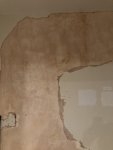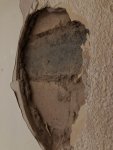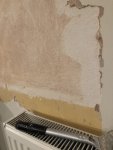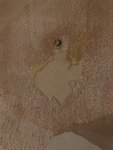Lookingforguidancepleasex
New Member
Hello, I moved in to my new home mid August and as we were getting it painted the decorator noticed that the skim on one kitchen wall was lifting off. So a lot of it cracked and fell away from tapping etc. This wall has layers on layers of plaster etc. There was historic damp from a leak in the bathroom above. So in the pictures you can see some of the most recent skim that was not cracked / lifted...the coarse layer underneath (potentially artex?)...then underneath that - more skim? Then red sand plaster with small stones in it...then brickwork.
My main issue right now is that I am terrified we have exposed atex on our kitchen wall? Some of it has broken away - the small hole where all the red sand has also fallen away and we are back to brick. All of this was incredibly loose, literally cracks appeared from tapping on the wall.
The painter and decorator that started to remove the skim did not say this could be artex.
We had a damp proof specialist come to check the wall - he did not mention any danger. He actually advised us to score the coarse layer with a stanley blade over and over to skim over it - we didn't do this.
We had a plasterer booked, we sent him pictures and videos of the job, he did not mention that the coarse layer underneath the skim could be artex. He didn't turn up in the end so we got another recommendation from a friend.
When the second plasterer came to look at the job he has warned that the coarse layer beneath the skim is artex. He has said he can't touch the wall until we have had a test. He assured us even if it does have asbestos, it will be low levels = low risk, but I am terrified now. I suffer with anxiety and this has knocked me bad. I watched my Grandad die struggling to breathe and he had worked with asbestos in his earlier years.
I've been googling like crazy and finding guidance that states that if you have white textured walls / ceilings and when you remove the top layer it is NOT white underneath, then this is likely plaster and NOT ARTEX so therefore not asbestos.
I sent pictures to a family friend in the trade he said it looks like "browning"...
I don't understand how we have had a decorator, a damp proof specialist, another plasterer look at the wall and NO ONE mentioned any risk what so ever, until our new plasterer comes yesterday and says he can't work on it until we have had it tested.
I need some guidance from professionals. What is the brown, coarse layer underneath the skim? What are the risks? How should we proceed with this wall? Any help would be very much appreciated.
My main issue right now is that I am terrified we have exposed atex on our kitchen wall? Some of it has broken away - the small hole where all the red sand has also fallen away and we are back to brick. All of this was incredibly loose, literally cracks appeared from tapping on the wall.
The painter and decorator that started to remove the skim did not say this could be artex.
We had a damp proof specialist come to check the wall - he did not mention any danger. He actually advised us to score the coarse layer with a stanley blade over and over to skim over it - we didn't do this.
We had a plasterer booked, we sent him pictures and videos of the job, he did not mention that the coarse layer underneath the skim could be artex. He didn't turn up in the end so we got another recommendation from a friend.
When the second plasterer came to look at the job he has warned that the coarse layer beneath the skim is artex. He has said he can't touch the wall until we have had a test. He assured us even if it does have asbestos, it will be low levels = low risk, but I am terrified now. I suffer with anxiety and this has knocked me bad. I watched my Grandad die struggling to breathe and he had worked with asbestos in his earlier years.
I've been googling like crazy and finding guidance that states that if you have white textured walls / ceilings and when you remove the top layer it is NOT white underneath, then this is likely plaster and NOT ARTEX so therefore not asbestos.
I sent pictures to a family friend in the trade he said it looks like "browning"...
I don't understand how we have had a decorator, a damp proof specialist, another plasterer look at the wall and NO ONE mentioned any risk what so ever, until our new plasterer comes yesterday and says he can't work on it until we have had it tested.
I need some guidance from professionals. What is the brown, coarse layer underneath the skim? What are the risks? How should we proceed with this wall? Any help would be very much appreciated.




